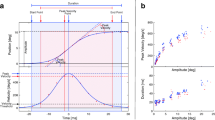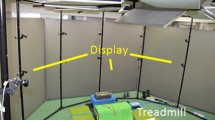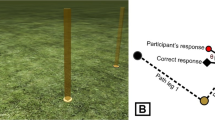Abstract
Coordination dynamics suggest that both in-phase and anti-phase movements are intrinsic and can be readily performed without practice. As movement frequency increases, individuals performing anti-phase movement inevitably switch to perform in-phase movement. However, due to different frames of reference used to define intrinsic coordination patterns in visual and kinesthetic domains, the perception of intrinsic coordination patterns could be ambiguous, which leads to the question whether the visually or kinesthetically perceived information is used to maintain the intrinsic coordination patterns. The current study explored how the consistency between visual and kinesthetic information would impact the performance and the associated metabolic energy consumption of intrinsic bimanual coordination patterns as movement frequency increased. Thirty participants were recruited and randomly assigned to one of three groups (“Info + Spatial +”, “Info + Spatial −”, and “Info-Spatial +”) to perform intrinsic bimanual coordination tasks using a computer-joystick system at low, high, and self-selected frequencies. The visual and kinesthetic information were manipulated to be either consistent or inconsistent by changing the spatial mapping between the motion of display and motion of joysticks. The results showed that the kinesthetic information was largely used to maintain the stability of intrinsic coordination patterns at high frequency, which could be an energy-conserving solution. However, spatial mapping alone seemed to be beneficial for keeping the visually perceived in-phase and anti-phase coordination patterns equally stable at low movement frequency, and spatially mapping the visual information to be consistent with kinesthetic information greatly enhanced the stability of anti-phase coordination. The dynamical use of visual and kinesthetic information for control of bimanual coordination is discussed.






Similar content being viewed by others
Notes
Participants saw two white dots moving rhythmically at the target relative phase, either in the same direction at the same time (in-phase), or in the opposite direction at the same time (anti-phase).
The feedback was given when the produced relative phase fell within the error bandwidth (i.e., ± 20°); the color of dots changed from white to green.
References
American College of Sports Medicine. (2016). ACSM’s guidelines for exercise testing and prescription. Tenth edit: Lippincott Williams & Wilkins.
Bingham, G. P. (2001). A perceptually driven dynamical model of rhythmic limb movement and bimanual coordination. In Proceedings of the 23rd Annual Conference of the Cognitive Science Society (pp. 75–79).
Bingham, G. P. (2004a). A perceptually driven dynamical model of bimanual rhythmic movement (and phase perception). Ecological Psychology, 16(1), 45–53.
Bingham, G. P. (2004b). Another timing variable composed of state variables: Phase perception and phase driven oscillators. Advances in psychology, 135, 421–442.
Bingham, G. P., Snapp-Childs, W., & Zhu, Q. (2018). Information about relative phase in bimanual coordination is modality specific (not amodal), but kinesthesis and vision can teach one another. Human Movement Science, 60, 98–106.
Bingham, G. P., Zaal, F. T., Shull, J. A., & Collins, D. R. (2001). The effect of frequency on the visual perception of relative phase and phase variability of two oscillating objects. Experimental Brain Research, 136(4), 543–552.
Bogaerts, H., Buekers, M. J., Zaal, F. T., & Swinnen, S. P. (2003). When visuo-motor incongruence aids motor performance: The effect of perceiving motion structures during transformed visual feedback on bimanual coordination. Behavioural Brain Research, 138(1), 45–57.
Brandes, J., Rezvani, F., & Heed, T. (2017). Abstract spatial, but not body-related, visual information guides bimanual coordination. Scientific reports, 7(1), 16732.
Brookings, J. B., Wilson, G. F., & Swain, C. R. (1996). Psychophysiological responses to changes in workload during simulated air traffic control. Biological Psychology, 42(3), 361–377.
Buekers, M. J., Bogaerts, H. P., Swinnen, S. P., & Helsen, W. F. (2000). The synchronization of human arm movements to external events. Neuroscience Letters, 290(3), 181–184.
Burton, D. A., Stokes, K., & Hall, G. M. (2004). Physiological effects of exercise. Continuing Education in Anaesthesia Critical Care & Pain, 4(6), 185–188.
Carroll, D., Turner, J. R., & Hellawell, J. C. (1986). Heart rate and oxygen consumption during active psychological challenge: The effects of level of difficulty. Psychophysiology, 23(2), 174–181.
Carroll, D., Turner, J. R., & Rogers, S. (1987). Heart rate and oxygen consumption during mental arithmetic, a video game, and graded static exercise. Psychophysiology, 24(1), 112–118.
Carson, R. G., Riek, S., Smethurst, C. J., Párraga, J. F. L., & Byblow, W. D. (2000). Neuromuscular-skeletal constraints upon the dynamics of unimanual and bimanual coordination. Experimental Brain Research, 131(2), 196–214.
Diedrich, F. J., & Warren, W. H., Jr. (1995). Why change gaits? Dynamics of the walk-run transition. Journal of Experimental Psychology: Human Perception and Performance, 21(1), 183.
Galna, B., & Sparrow, W. A. (2006). Learning to minimize energy costs and maximize mechanical work in a bimanual coordination task. Journal of Motor Behavior, 38(6), 411–422.
Haken, H., Kelso, J. S., & Bunz, H. (1985). A theoretical model of phase transitions in human hand movements. Biological Cybernetics, 51(5), 347–356.
Hoyt, D. F., & Taylor, C. R. (1981). Gait and the energetics of locomotion in horses. Nature, 292(5820), 239.
Huang, S., Dai, B., & Zhu, Q. (2019). Advantage of early focus on visual information in bi-modal training of bimanual coordination. Multisensory research, 1(aop), 1–21.
Kelso, J. A. (1984). Phase transitions and critical behavior in human bimanual coordination. American Journal of Physiology-Regulatory, Integrative and Comparative Physiology, 246(6), R1000–R1004.
Kelso, J. S., Holt, K. G., Kugler, P. N., & Turvey, M. T. (1980). On the concept of coordinative structures as dissipative structures: II. Empirical lines of convergence. Advances in Psychology, 1, 49–70.
Kelso, J. A. S., Scholz, J. P., & Schöner, G. (1986). Nonequilibrium phase transitions in coordinated biological motion: Critical fluctuations. Physics Letters A, 118(6), 279–284.
Kovacs, A. J., Buchanan, J. J., & Shea, C. H. (2009). Bimanual 1:1 with 90° continuous relative phase: Difficult or easy! Experimental Brain Research, 193(1), 129–136.
Kovacs, A. J., & Shea, C. H. (2011). The learning of 90 continuous relative phase with and without Lissajous feedback: External and internally generated bimanual coordination. Acta Psychologica, 136(3), 311–320.
Kugler, P. N., Kelso, J. S., & Turvey, M. T. (1980). On the concept of coordinative structures as dissipative structures: I. Theoretical lines of convergence. Tutorials in motor behavior, 3, 3–47.
Li, Y., Levin, O., Carson, R. G., & Swinnen, S. P. (2004). Bimanual coordination: constraints imposed by the relative timing of homologous muscle activation. Experimental Brain Research, 156(1), 27–38.
Li, Y., Levin, O., Forner-Cordero, A., Ronsse, R., & Swinnen, S. P. (2009). Coordination of complex bimanual multijoint movements under increasing cycling frequencies: The prevalence of mirror-image and translational symmetry. Acta Psychologica, 130(3), 183–195.
Marteniuk, R. G., MacKenzie, C. L., & Baba, D. M. (1984). Bimanual movement control: Information processing and interaction effects. The Quarterly Journal of Experimental Psychology Section A, 36(2), 335–365.
Mechsner, F., Kerzel, D., Knoblich, G., & Prinz, W. (2001). Perceptual basis of bimanual coordination. Nature, 414(6859), 69.
Oldfield, R. C. (1971). The assessment and analysis of handedness: The Edinburgh inventory. Neuropsychologia, 9(1), 97–113.
Pickavance, J., Azmoodeh, A., & Wilson, A. D. (2018). The effects of feedback format, and egocentric & allocentric relative phase on coordination stability. Human Movement Science, 59, 143–152.
Ren, J., Huang, S., Zhang, J., Zhu, Q., Wilson, A. D., Snapp-Childs, W., & Bingham, G. P. (2015). The 50 s cliff: A decline in perceptuo-motor learning, not a deficit in visual motion perception. PLoS One, 10(4), e0121708.
Snapp-Childs, W., Wilson, A. D., & Bingham, G. P. (2011). The stability of rhythmic movement coordination depends on relative speed: The Bingham model supported. Experimental Brain Research, 215(2), 89–100.
Snapp-Childs, W., Wilson, A. D., & Bingham, G. P. (2015). Transfer of learning between unimanual and bimanual rhythmic movement coordination: Transfer is a function of the task dynamic. Experimental Brain Research, 233(7), 2225–2238.
Sparrow, W. A., & Newell, K. M. (1998). Metabolic energy expenditure and the regulation of movement economy. Psychonomic Bulletin & Review, 5(2), 173–196.
Swinnen, S. P. (2002). Intermanual coordination: From behavioural principles to neural-network interactions. Nature Reviews Neuroscience, 3(5), 348.
Swinnen, S. P., Dounskaia, N., & Duysens, J. (2002). Patterns of bimanual interference reveal movement encoding within a radial egocentric reference frame. Journal of cognitive neuroscience, 14(3), 463–471.
Swinnen, S. P., Jardin, K., Meulenbroek, R., Dounskaia, N., & Den Brandt, M. H. V. (1997). Egocentric and allocentric constraints in the expression of patterns of interlimb coordination. Journal of Cognitive Neuroscience, 9(3), 348–377.
Swinnen, S. P., Young, D. E., Walter, C. B., & Serrien, D. J. (1991). Control of asymmetrical bimanual movements. Experimental Brain Research, 85(1), 163–173.
Temprado, J. J., Swinnen, S. P., Carson, R. G., Tourment, A., & Laurent, M. (2003). Interaction of directional, neuromuscular and egocentric constraints on the stability of preferred bimanual coordination patterns. Human Movement Science, 22(3), 339–363.
Wilson, A. D., Bingham, G. P., & Craig, J. C. (2003). Proprioceptive perception of phase variability. Journal of Experimental Psychology: Human Perception and Performance, 29(6), 1179.
Wilson, A. D., Snapp-Childs, W., & Bingham, G. P. (2010a). Perceptual learning immediately yields new stable motor coordination. Journal of Experimental Psychology: Human Perception and Performance, 36(6), 1508.
Wilson, A. D., Snapp-Childs, W., Coats, R., & Bingham, G. P. (2010b). Learning a coordinated rhythmic movement with task-appropriate coordination feedback. Experimental Brain Research, 205(4), 513–520.
Wilson, A. D., Tresilian, J. R., & Schlaghecken, F. (2011). The masked priming toolbox: an open source Matlab toolbox for masked priming researchers. Behavior Research Methods, 43, 210–214.
Zhu, Q., Mirich, T., Huang, S., Snapp-Childs, W., & Bingham, G. P. (2017). When kinesthetic information is neglected in learning a Novel bimanual rhythmic coordination. Attention, Perception, & Psychophysics, 79(6), 1830–1840.
Acknowledgements
This study was funded by the UW College of Health Sciences Student Research Grant awarded to the first author. This study was also made possible by an Institutional Development Award (IDeA) from the National Institute of General Medical Sciences of the National Institutes of Health under Grant # 2P20GM103432. Its contents are solely the responsibility of the authors and do not necessarily represent the official views of NIH.
Author information
Authors and Affiliations
Corresponding author
Ethics declarations
Conflict of interest
All authors declare that they have no conflict of interest.
Ethical standards
All procedures performed in studies involving human participants were in accordance with the ethical standards of the institutional and/or national research committee and with the 1964 Helsinki declaration and its later amendments or comparable ethical standards. This article does not contain any studies with animals performed by any of the authors.
Informed consent
Informed consent was obtained from all individual participants included in the study.
Additional information
Publisher's Note
Springer Nature remains neutral with regard to jurisdictional claims in published maps and institutional affiliations.
Rights and permissions
About this article
Cite this article
Huang, S., Van Syoc, B., Yang, R. et al. Using visual and/or kinesthetic information to stabilize intrinsic bimanual coordination patterns is a function of movement frequency. Psychological Research 85, 865–878 (2021). https://doi.org/10.1007/s00426-020-01288-2
Received:
Accepted:
Published:
Issue Date:
DOI: https://doi.org/10.1007/s00426-020-01288-2




